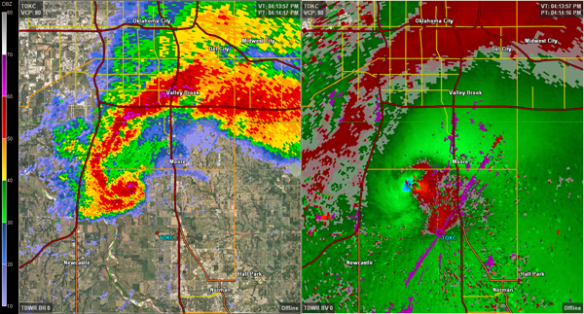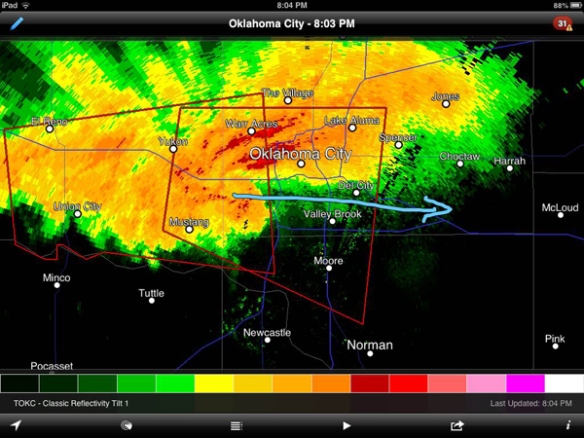For the last two weeks, it seems there has been an endless stream of stories about storm damage and tornadoes in Oklahoma. First, tornadoes cut through central and northeastern Oklahoma on May 19th. Second, it was the EF5 tornado that hit Moore, Oklahoma on May 20th; a debris ball and intense rotation could be seen on radar long before the storm hit Moore:
Third, there was a large tornadic, supercell thunderstorm approaching Oklahoma City on May 31st. Several tornadoes were confirmed from this cyclic thunderstorm, and 80+ mph rear-flank downdraft winds blasted southern Oklahoma City and northern Moore:
The May 20th tornado killed 24 people, and the death toll has not been solidified for the May 31st storms.
While it is horrible to hear of any tornado-related deaths, deaths in EF-5 tornadoes are common. Given span of the debris field, the timing of the day, the length and width of the tornado (17 miles, and a maximum of 1.3 miles, respectively), and the path of the tornado (through a medium to large-sized city), the death toll in and around Moore easily could have been much higher. Advanced warning from the media and the National Weather Service likely saved dozens of lives.
Preliminary assessments from the National Weather Service in Norman, Oklahoma suggest the tornadoes that hit Oklahoma City and surrounding areas on May 31st were weaker overall but were still deadly. Many of the deaths that day could have easily been prevented.
Tragically, legendary Tim Samaras, his son Paul Samaras, and longtime chase partner Carl Young were killed in the EF-3 tornado that hit El Reno, Oklahoma on Friday. More information on the death of these three storm chasers from 7NEWS in Denver is here: http://bit.ly/11xAcZ4
Mike Bettes, a meteorologist at The Weather Channel, and his crew were injured when their car was damaged by one of the tornadoes on May 31st. More information (including a photo of the damaged car) from the AP via WPTV-TV is here: http://bit.ly/ZmKWx1
Personally, I was more surprised to hear of these storm chaser/meteorologist injuries and deaths on May 31st more than the injuries and deaths in the Moore tornado on May 20th. When a major tornado hits a city with 55,000+ residents, there will almost certainly be injuries and deaths. Some who take shelter but not underground will get killed and/or injured when a tornado is that strong.
While it is important to tend to injuries and remember the lives of those who are killed in storms, there are few if any reasons why a storm chaser or meteorologist should be killed by a tornado. Storm chasers – especially those who are meteorologists – should know the level of danger in and especially around thunderstorms. If they don’t know the danger, they should keep more than enough distance or they shouldn’t be chasing at all. Those with limited or no training or experience should not go chasing potentially violent tornadoes, just as those with limited or no medical training should not be in charge of large-scale safety operations. The “Particularly Dangerous Situation” Tornado Watch in effect before tornadoes hit the Oklahoma City area on May 31st made it very clear that intense tornadoes were possible that afternoon and evening: http://1.usa.gov/11bxp7S. Reports of multi-vortex tornadoes in the area should have been a clear sign that tornadoes may dissipate and develop quickly, including overhead and away from where they were looking. Reports on Twitter Friday night suggested that at least one OKC meteorologist told people to drive away from the projected path of the tornadoes and that roads were clogged by these evacuees and storm chasers. People caught in traffic and not able to escape with a tornado approaching a recipe for disaster.
May 31st serves as a reminder that dangerous storms are dangerous. Experience and training may help someone get closer to a storm or know how to escape if needed, but there will always be cases where experience and training won’t help or save you. Unfortunately, storms can some and sometimes claim lives, including those who think they can outwit them.
This cat and mouse game has to stop. When meteorologists and storms chasers are getting injured and killed, we need to reconsider storm chasing policies and behavior. The risk of getting killed and watching our friends, loved ones, and colleagues get killed is not worth the risk of sampling the winds in or getting a picture of a tornado. Storms aren’t going to change the way they do what they do; it is up to us to make a change.



Sure, there are few reasons why chasers should be killed, but a tornado changing direction unexpectedly would be one of those reasons, wouldn’t you agree? By all accounts, that’s what happened.
Scott, you are 100% correct. To see folks standing in hurricane force winds or flood waters up to their butts add nothing to the report but does make me wonder about the value.
Well said Scott, well said…Even if a tornado changes direction with the technology that is available in these chase vehicles, I have some of that very technology in my vehicle, an experienced met or chaser can predict movement. While it was sad Tim, Paul, and Carl died; it could and should have been prevented.